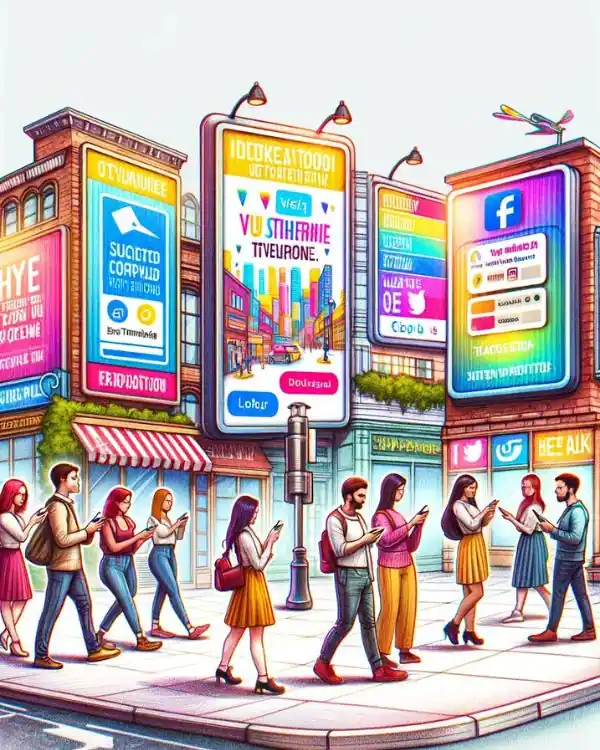Advertisement
By IS Team
Essential Tips For Integrating Social Media Into Corporate Invitations

Advertisement
Integrating social media into corporate invitations enhances the accessibility, engagement, and success of events. By seamlessly blending social media features into invitations, organisers can extend their reach, foster real-time interactions, and gather vital analytics.
This strategy transforms invitations from simple announcements into dynamic, interactive platforms, making each event not just a gathering but a part of a vibrant, connected community. Embrace this approach to make your events more engaging and memorable, truly leveraging the power of digital connectivity.
Benefits of Integrating Social Media in Corporate Invitations

Advertisement
- Extended Reach and Visibility 🌐: Leveraging social media platforms allows your event to reach a broader audience. It’s an effective way to ensure your invitation extends beyond local geographies and catches the eye of potential attendees worldwide.
- Enhanced Attendee Engagement 👥: Social media opens up new avenues for interaction. Engaging with your attendees through these platforms before, during, and after the event keeps the conversation going and builds community.
- Real-Time Updates and Interactions ⏰: Keep your attendees in the loop with instant updates about event schedules, speakers, or any unforeseen changes. Real-time interactions keep the energy high and the participants engaged.
- Gathering Analytics and Feedback 📊: Social media platforms provide valuable data on attendee engagement and event reach. This data can be crucial for measuring the success of your event and planning future strategies.
Key Social Media Platforms for Corporate Invitations
- Facebook: Harness the power of event creation tools, streamlined RSVP options, and extensive network effects to boost your event’s visibility.
- LinkedIn: This professional network is perfect for targeting corporate attendees, sharing industry-related content, and fostering professional relationships.
- Twitter: Ideal for quick announcements and live updates. Its fast-paced nature keeps your audience informed and engaged in real time.
- Instagram: Use this visually oriented platform to attract a younger audience with compelling images and stories from your event.
Designing Social Media Friendly Invitations

To ensure it resonates with your audience and leverages the power of social media, follow these essential guidelines:
Visual Appeal and Branding Consistency 🎨
Make a lasting first impression with invitations that mirror your brand’s identity. Consistent use of your company's colours, fonts, and logos makes your invitations striking and instantly recognizable. This coherence ensures that every event element reflects your corporate identity, enhancing brand loyalty and trust.
Integration of Social Media Icons and Hashtags 🔗
Transform your invitations into a gateway for digital interaction by incorporating social media icons. These icons should link directly to your event’s social media pages, creating a seamless transition from invitation to online engagement. Utilise unique hashtags specifically crafted for your event to ignite conversations and enable easy sharing. These hashtags become your event’s digital fingerprint, amplifying visibility and encouraging widespread participation.
Mobile Optimization📱
With the majority of social media engagement occurring on mobile devices, it is critical to ensure that your invitations are mobile-friendly. Opt for a clean, navigable design that looks great on both large and small screens to guarantee a frictionless user experience. This mobile-first approach ensures that recipients can interact with your invitation anytime, anywhere, boosting the likelihood of RSVPs and shares.
Use of QR Codes 🔍
In an age where efficiency is key, integrating QR codes in your digital invitations offers attendees a quick-access pass to further event details, social media platforms, or exclusive content. This simple scan-and-go solution not only enhances the user experience but also positions your event as technologically adept and user-focused.
Strategies for Promoting Corporate Events on Social Media

Advertisement
In the digital age, promoting your corporate events on social media isn't just an option—it's essential for reaching a wider audience and generating buzz. Here’s how you can effectively leverage social media to make your next event a success:
Creating Event Pages or Groups
Establish a central hub for your event by creating dedicated pages or groups on platforms like Facebook or LinkedIn. This space becomes the go-to spot for all things related to your event, from schedules to speaker bios to interactive discussions. It not only serves as an information repository but also fosters a community among attendees, encouraging them to share the event within their networks and engage with the content you post.
Paid Advertisements 🎯
Unlock the power of targeted advertising to ensure your event reaches the exact audience you desire. Platforms like Facebook, Instagram, and LinkedIn offer sophisticated targeting tools that allow you to specify demographics such as age, location, and interests. This tailored approach ensures that every dollar spent maximises your reach and attracts potential attendees who are most likely to be interested in your event.
Sharing Teasers and Key Highlights 🌟
Spark curiosity and maintain interest by sharing teasers and previews of what attendees can expect. Highlight exciting elements of your event, such as keynote speakers, exclusive content, or special entertainment. These sneak peeks keep your audience engaged and excited, building anticipation as the event approaches. Think of these shares as the trailer to your blockbuster event—they set the tone and raise expectations.
Collaborating with Influencers or Partners
Amplify your event’s visibility by partnering with influencers and other businesses in your industry. These partners can act as event ambassadors, promoting your event to their sizable followers. Choose collaborators whose audiences align with your target demographic to ensure the message resonates and converts. This strategy not only extends your reach but also adds a layer of credibility and allure to your event.
Engagement Tactics During the Event

- Live Tweeting and Streaming 📹: Keep both attendees and followers updated with live feeds of the event, making it accessible even from afar.
- Encouraging Sharing 🔄: Motivate attendees to share their experiences and photos, enhancing community involvement and visibility.
- Interactive Polls and Quizzes ❓: Engage your audience with fun and interactive content that can also provide feedback on the event.
- Dedicated Event Hashtags #️⃣: Use specific hashtags to streamline discussions, photos, and posts about the event, making them easy to find and follow.
Post-Event Engagement and Analysis
After the curtains close on your corporate event, the engagement doesn't have to end. Effective post-event strategies can help you sustain interest, gather valuable feedback, and set the stage for future events. Here’s how to keep the momentum going and extract insightful data from your event's social media activities:
Thanking Attendees and Sharing Highlights ✨
Expressing gratitude is not just good manners—it’s a powerful engagement tool. Thank participants for their attendance with personalized thank you messages that make them feel valued and appreciated. Alongside your thanks, share captivating highlights and memorable moments from the event. This could be through a well-crafted video, a photo album, or standout quotes from speakers. These shares help prolong the life of your event in the digital world, reminding attendees of the experience and showing non-attendees what they missed.
Analyzing Social Media Metrics 📈
Data is your most reliable post-event asset. Dive deep into the analytics provided by social media platforms to measure your event’s digital footprint. Look at metrics such as reach, engagement rates, and the performance of specific posts or ads. Understanding these can tell you what worked and what didn’t, providing crucial insights that can improve your strategies for future events. Analyzing participant feedback, both qualitative and quantitative, helps refine your audience engagement and content delivery.
Leveraging Post-Event Engagement
Use the buzz generated by your event as a springboard for ongoing engagement. Continue the conversation by posting follow-up content, like session recordings or answers to questions that couldn't be addressed during the event. Encourage attendees to share their own stories and experiences, which helps maintain community spirit and keeps your event in discussions longer. These interactions not only enhance customer loyalty but also fuel your content pipeline, providing material for future marketing efforts and event planning.
Incorporating social media into your corporate invitations not only enhances the event experience but also amplifies your marketing efforts, making every event a potential stepping stone for greater success. Embrace these strategies to bring a dynamic, interactive, and successful element to your corporate events!
Frequently Asked Questions
Q1. How early should I start promoting my event on social media?
Ans: Begin promoting your event on social media at least 6-8 weeks in advance. This time frame allows you to build anticipation, engage potential attendees through various content, and adjust your strategy based on the audience's response.
Q2. Can social media integration help in reducing event costs?
Ans: Yes, integrating social media can help reduce costs by minimising the need for physical promotional materials and leveraging digital ads that are often more cost-effective compared to traditional media.
Q3. What are the risks of using social media in corporate invitations?
Ans: The main risks include potential privacy issues, the spread of misinformation if not managed correctly, and the dependence on digital platforms which might alienate non-tech-savvy attendees.
Q4. How do I handle negative feedback on social media regarding my event? Ans: Address negative feedback promptly and professionally. Publicly acknowledge the issue, offer a solution or clarification, and take the conversation offline if necessary to resolve any specific concerns. This approach shows commitment to attendee satisfaction and can turn a negative into a positive.
Advertisement
I'm Looking For!








